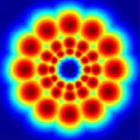A computational model of the motion after-effect
The motion after-effect (MAE) is a phenomenon in which prolonged viewing of a moving stimulus results in the perception of illusory motion in the opposite direction. The MAE is believed to be caused by adaptation of motion sensitive neurons in the brain. The MAE comes two forms. In the static MAE the post-adaptation stimulus is a static pattern. In the dynamic MAE the post-adaptation stimulus is a pattern containing balanced motion cues. Examples of dynamic stimuli include flickering gratings; random visual noise (such as the static on a television); and patterns of dots moving in random directions. A model of motion adaptation proposed by van de Grind et al (2003) has been demonstrated to produce a dynamic MAE that fits well with the psychophysical data on the effect. However, to the author's knowledge, this model has yet to be demonstrated to generate a static MAE. This study incorporates this model of adaptation into two of the standard models of mammalian vision (the gradient model and the motion energy model) to determine if it can produce a static MAE and, if it does, how well it corresponds to the relevant psychophysical data. The gradient model implementation does not produce a static MAE. However, the energy model implementation produces a static MAE that fits much of the available psychophysical data. However, it also produces a spurious MAE at very low spatial frequencies. This is not only absent from all the psychophysical studies, but also masks any other cause of MAE for a range of adaptor and test stimulus combinations. This makes it impossible to evaluate the model MAE against the full set of psychophysical data. However, for those data against which a comparison is possible, the model MAE is qualitatively consistent with the majority of the data. The use an alternative set of filters in the energy model is expected to eradicate this spurious MAE and permit a full comparison of the model MAE with all the available psychophysical data.

Spatio-temporal frequency response of 3 nested sets of oriented Gabor filters

